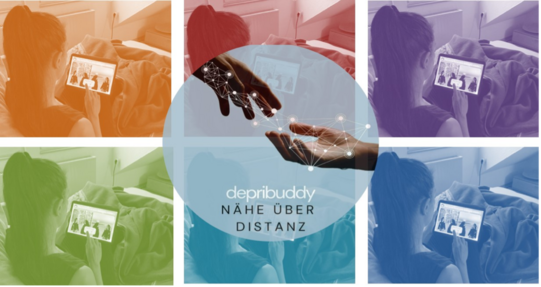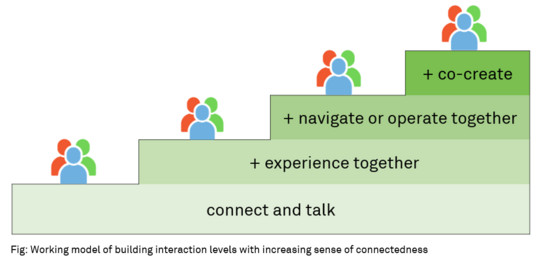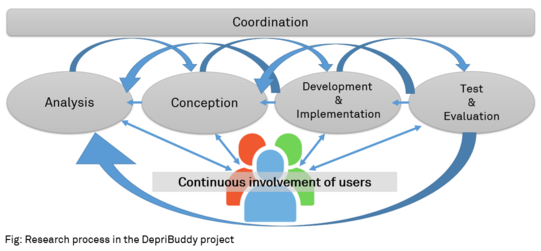DepriBuddy - Design Thinking-based modelling of mediatised proximity and app development for a self-help network
Research area Labour policy and health | Kerstin Guhlemann | Sonja Kirschall | Iris Wroblewski | Pia-Saskia Berg
Within the DepriBuddy project, an interdisciplinary network with perspectives from sociology, psychology and media studies is conducting application-oriented research into the media-supported creation, maintenance and expansion of social ties and closeness.
Bundesministerium für Bildung und Forschung (BMBF)
The DepriBuddy project explores ways of creating, maintaining and strengthening closeness and connection through joint virtual leisure activities and everyday coping in the target group of people facing mental health problems. To this end, the project network is developing a software solution that is optimally tailored to people with depressive symptoms and is researching its application. The focus is on a group of people who find it difficult to maintain active social relationships and whose communicative needs are not sufficiently taken into account by existing social media. Social networks such as Facebook and Instagram tend to benefit people who are socially active anyway, whereas for psychologically challenged people and especially those with depressive symptoms, they often do not lead to a stronger experience of inclusion and an improvement in psychological well-being for various reasons, but on the contrary might negatively influence stressful moods and harmful self-relationships due to their attention economy.
DepriBuddy aims to combine proximity-generating strategies and features of different socially connecting media - social media networks, media sharing platforms, ASMR videos, virtual walks, multiplayer games and self-help apps - in order to transform their respective weaknesses into strengths with regard to the project’s target group. In this way, a low-threshold offer with high user loyalty is to be created that is suitable for networking and support, especially for smaller groups of people with special social support needs.
The scientific research and modelling of mediatised affiliation, which is interlinked with the steps of app development, implementation and testing, is based on a four-stage working model of differentiable, successive interaction stages, which are assumed to be able to generate a gradually increasing experience of affiliation (see fig.).
According to the coverage of the different levels of interaction, the functionalities and contents of the app should be designed and created to generate feelings of social cohesion and active support in different ways: by fostering intersubjective exchange through the sensory qualities of shared media content, by non-touch teletactility strategies, spatially and temporally synchronising events, shared virtual multi-sensory experiences and mini-games, cooperative ventures and creative art projects.
Cooperation partners:
- University of Greifswald, Institute for Psychology
- Rocket Apes GmbH
Contractor:
- Actor from the field of self-help
- Actor from the field of social art
Associated partners:
- Deutsche DepressionsLiga e. V.
- Schatten & Licht e. V.
- Der Paritätische NRW Selbsthilfe-Kontaktstelle Kreis Euskirchen
- Mutmachleute e. V.
- Anderes Burnout Café Düsseldorf / Bundesverband Burnout und Depression e. V.
- rehapro-Projekt GUIDE im JobCenter Unna
- Gesellschaft für soziale Anerkennung e. V.
- Arbeitsgemeinschaft Selbsthilfe behinderter Menschen in Essen e. V. (AGSBM)
The research process is based on a structured research of studies on phenomena of media-supported affiliation processes and mediated intimacy, which serves two purposes: Firstly, a research map is created that locates the project and relates the four levels of mediated closeness and attachment hypothesised heuristically in the project design to existing categorisation systems. Secondly, suggestions for the concrete design of the app are collected and compared with the views of the target group. These findings on effective design aesthetics and modalities of use on the one hand, and the technical development of the app on the other hand, are connected with each other in mutual quality assurance and specification according to the method of design thinking with several feedback loops under continuous user participation (see fig.).
The ongoing inclusion of the target group improves the app’s aptitude and at the same time creates a clearly defined subject and phenomenon area (the social-media structure of target group and interface) in which aesthetic media analysis can be interlocked with sociological and psychological qualitative and quantitative empiricism. The resulting questions guide the adaptation of the app to the needs.
Evaluation of the effectiveness of the app in terms of perceived closeness, connectedness, community-building and quality of life will be carried out by the Chair of Health and Prevention at the University of Greifswald and will proceed psychologically-empirically with a mixed methods design, whereby opportunities and risks of later use will be identified from a technology acceptance perspective. The measurement parameters are based on the evaluation criteria to be developed in the project as well as on the CIVIC model for measuring social connectedness.
The project pursues the practical goal of developing a low-threshold and motivating app to create, maintain and consolidate social connectedness through a wide range of interpersonal interactions - from simple discursive exchanges and sharing of media content, to synchronisation of everyday tasks, to telepresent and virtual co-present experiences such as virtual walks and co-creation events facilitated by social art practitioners. The diversity and interactivity of the offers, as well as certain involving elements such as push messages with reminders and invitations, gamification strategies, but also the creation of interpersonal commitments (matching and buddy system) should promote long-term user loyalty.
This is accompanied by the scientific goals of fostering a detailed understanding of the functionalities of media-supported connectedness with regard to the required media design aesthetics, modalities of use and psychophysical effective potentials, which shall be modelled transferably and set in relation to the state of knowledge and research with regard to mediatised affiliation processes of the disciplines involved. In the process, hypotheses that have been incorporated into a four-stage working model of mediatised proximity and connectedness formulated in the project design shall be tested.
Here, the sfs also aims in particular to gain a detailed understanding of the usage situations, needs, potentials and resistances in the technical support of social interactions through qualitative in-depth exploration of the proximity needs of the target group in various everyday situations and their gratification expectations, and to open these up for other application contexts.




![[Translate to English:] [Translate to English:]](/storages/zentraler_bilderpool/_processed_/a/f/csm_Kontakt_b86e8d8ecc.png)
![[Translate to English:] [Translate to English:]](/storages/sfs-sowi/_processed_/6/c/csm_Glasfront_sfs_Header_eae6d325d3.jpg)


